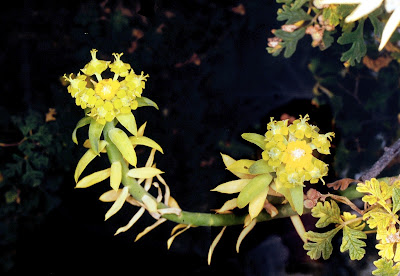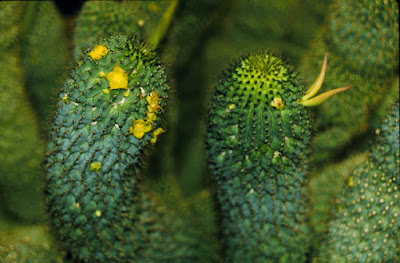 |
| Euphorbia stellospina remarkably mimics the growth form of cacti native to the Americas. One cllue is the forked spines found only in Euphorbia. |
One first thinks of cacti when the word succulent comes up, and they are almost completely confined to the Americas. None occur in southern Africa. With some 1500 species of cacti, one might think the Americas would have the greatest collection of succulents. We can add to their numbers some 200 species of Agave and many members of the Crassulaceae, but in Africa, the role of succulent is filled with members of an even greater variety of families.
 |
| Pachypodium namaquensis (Apocynaceae) is related to Nerium oleander, periwinkle, and confederate jasmine.. |
It's hard to put a number to this collection, but I believe it exceeds the number of succulents in the new world. For example, the stapeliads consist of 29 genera, each with a number of species. The genus Stapelia alone has 55 species. Euphorbia consists of over 2000 species worldwide, and includes tiny herbs, trees, and about 1000 cactus-like succulents in Africa. The genus Aloe, all succulent and mostly native to Africa consist of 500 species, the Crassulaceae contains several hundred here, and so the number builds up. Aizoaceae, a family with succulent leaves contains 1782 species in Africa.
So I rest my case for southern Africa possessing the greatest treasure chest of succulents, and invite you to enjoy the pictures.
 |
| Pelargonium spinosum is a spiny, succulent member of the large genus featured earlier in this series. |
 |
| This Agyroderma (Aizoaceae), like the related genus Lithops, typically maintain only two functional leaves that are half- buried in the rocky soil, and have the common name of living stones. |
 |
| A stop at the Kokerboom Nursery, gave us a great preview of the native succulents of South Africa. |
 |
| Tylecodon paniculatus (Crassulaceae) is a common desert shrub in southern Africa. |
 |
| The attractive blossoms of Tylecodon paniculatus. |
This planter box features living stones and other members
of the Aizoaceae. |
 |
| Euphorbia mauritanica has slender succulent stems, and leaves during the rainy season. |
 |
| Euphorbia tuberculata; one of many cactus-like species in this genus. |
 |
| Orbea ciliata is a cactus-like member of the stapeliad group of the Asclepiadaceae. |
 |
| Sarcocaulon crassicaule is a succulent member of the Geraniaceae. |
 |
| Aloe erinacea; a small, spiny member of this large African genus. |
 |
| Larryleachia cactiformis, a stapeliad with small, dark flowers. |
 |
| Aloe pitchifolia at the Kokerboom Nursery. |
 |
| Aloe framesii |
 |
| Aloe chabaudii |
 |
| Trichocaulon flavum, another stapeliad; note the milkweed-like follicles on the stem on the right. |
 |
| Eupohrbia clandetina; another succulent with temporary leaves. |
 |
| Wild Aloe dichotoma trees on a rocky hillside. |
The bark of Aloe dichotoma forms patches of different color.



No comments:
Post a Comment
Note: Only a member of this blog may post a comment.